This pot hasn’t just been repaired — it’s been remade.
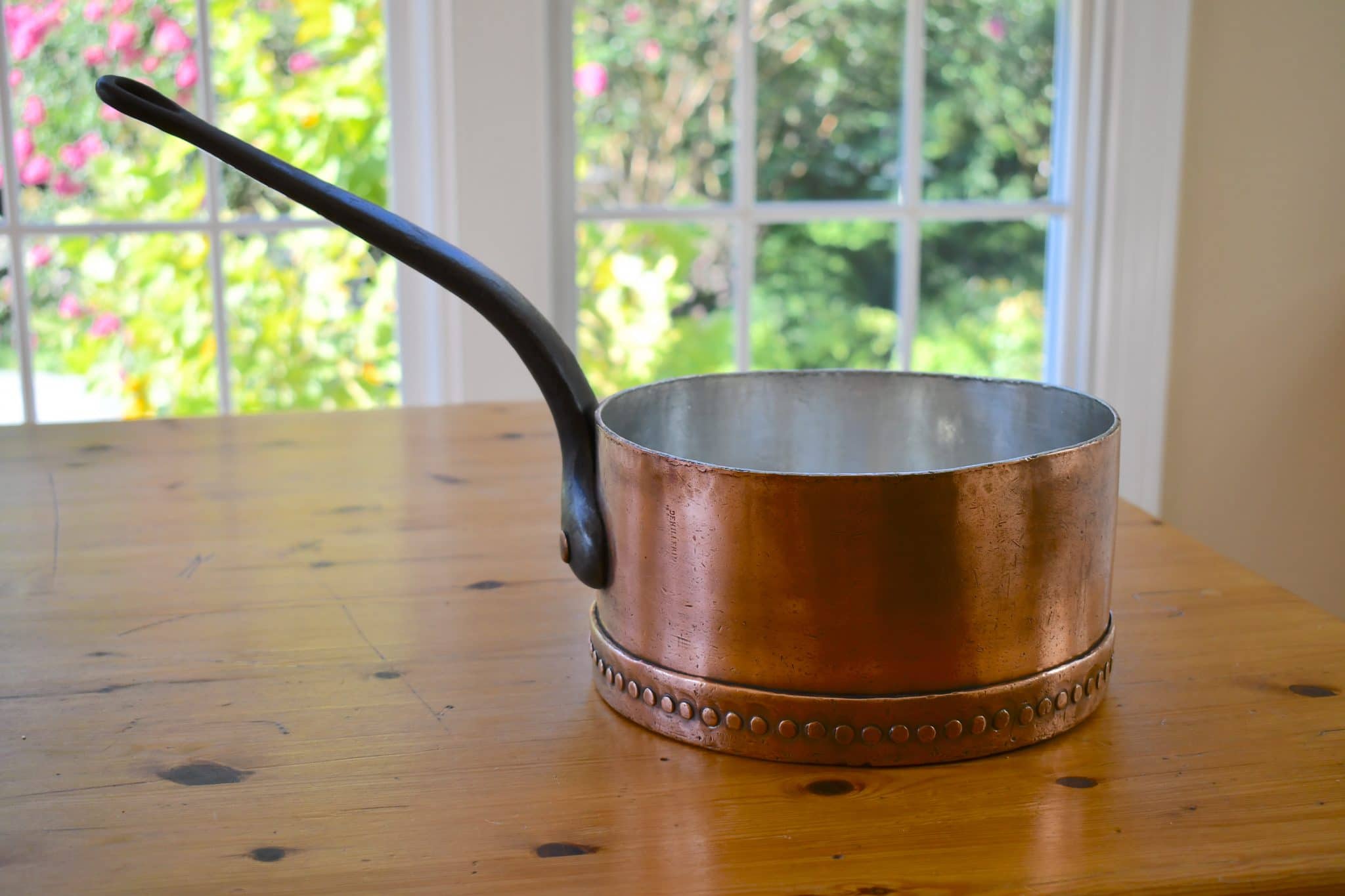
| Type | Tin-lined saucepan in hammered finish with copper-riveted replacement base and replaced cast iron handle attached with three copper rivets |
| French description | Casserole étamée et martelée avec base remplacée rivetée en cuivre et queue fer remplacé munie de trois rivets en cuivre |
| Dimensions | 23cm diameter by 12cm tall (9.1 by 4.7 inches) |
| Thickness | 2.8mm at rim |
| Weight | 5158g (11.4 lbs) |
| Stampings | DEHILLERIN 18 RUE COQUILLIÈRE |
| Maker and age estimate | Unknown, 1890-1900(?) |
| Source | Etsy (France) |
The unusual riveting around this pot’s base is what caught my eye, but when I was able to hold and examine it, I realized that the repair to the base is only part of this pot’s story.
The body of the pot
 Sometime between 1890 and 1900, a French coppersmith made this saucepan for the Dehillerin store in Paris. Eugène Dehillerin was a coppersmith but his eponymous store also sold pieces by other makers. Every pot was stamped with the store’s name and address at 18 Rue Coquillière but there are several versions of stamp with minor variations. I suspect each version came from a different supplier: Dehillerin’s own workshop, Gaillard, Legry, Duval, or any number of Parisian makers. As of yet I don’t know which stamp came from which maker but they are all beautiful pieces that exemplify French craftsmanship at the height of the golden age of antique copper.
Sometime between 1890 and 1900, a French coppersmith made this saucepan for the Dehillerin store in Paris. Eugène Dehillerin was a coppersmith but his eponymous store also sold pieces by other makers. Every pot was stamped with the store’s name and address at 18 Rue Coquillière but there are several versions of stamp with minor variations. I suspect each version came from a different supplier: Dehillerin’s own workshop, Gaillard, Legry, Duval, or any number of Parisian makers. As of yet I don’t know which stamp came from which maker but they are all beautiful pieces that exemplify French craftsmanship at the height of the golden age of antique copper.
What this means is that the Dehillerin stamp on this pot does not necessarily mean that it was made by Eugene Dehillerin — unless, of course, it was. But regardless of who made it, this was a high-quality pot. It measures between 2.8mm and 3mm thick at various points around the rim, and an inch or so lower thickens to 3mm to 3.2mm and may be thicker still towards the base. It’s not unusual for mid-19th century pots to be bottom-heavy; a pot hand-raised from a flat sheet of copper may have thinner sidewalls, particularly on cone-shaped Windsor pans. This tapered thickness has a cooking consequence as well: having the greatest mass of metal towards the base of the pan where it comes into direct contact with food puts the copper in the best place to spread and equalize cooking heat. The French coppersmiths knew this, of course, and so even into the early 20th century some makers continued tapering their pots even when metal presses made it possible to produce pans of perfectly consistent thickness; Gaillard showed a cut-away diagram of its tapered copper pots in its catalogs as late as 1956.
The base
At some point the pot suffered some sort of damage to the degree that its base needed repair. Copper is a soft metal and many older pans are deformed in some way — dented, a little out of round, or convex in the base so that they don’t sit flat. But given the thickness of this pot’s sidewalls and its relatively small diameter, the damage must have been pretty severe. Instead of patching the damage, the smith decided to replace the base. He sheared away the base of the pot, formed a piece of copper into a shallow cup shape, set the pan body into it, and fixed the two pieces in place with a row of 67 copper rivets.

It is a marvel. Each rivet has a neat round exterior head and is set flush flat against the interior surface. Imagine for a moment what it must have been like to drill each hole, insert a rivet, and work right up against the base of the pan to finish it. I can’t imagine a riveting machine that could fit in this tight space and so I suspect this must have been done completely by hand. Look at how beautiful the rivets are — there are slight variations in the set of each one as is to be expected for hand-work like this, but they are all even and pleasing to the eye. This is masterful work.
I estimate that the base piece is 2mm to 2.5mm thick around its visible edge and likely just as thick across the flat portion.
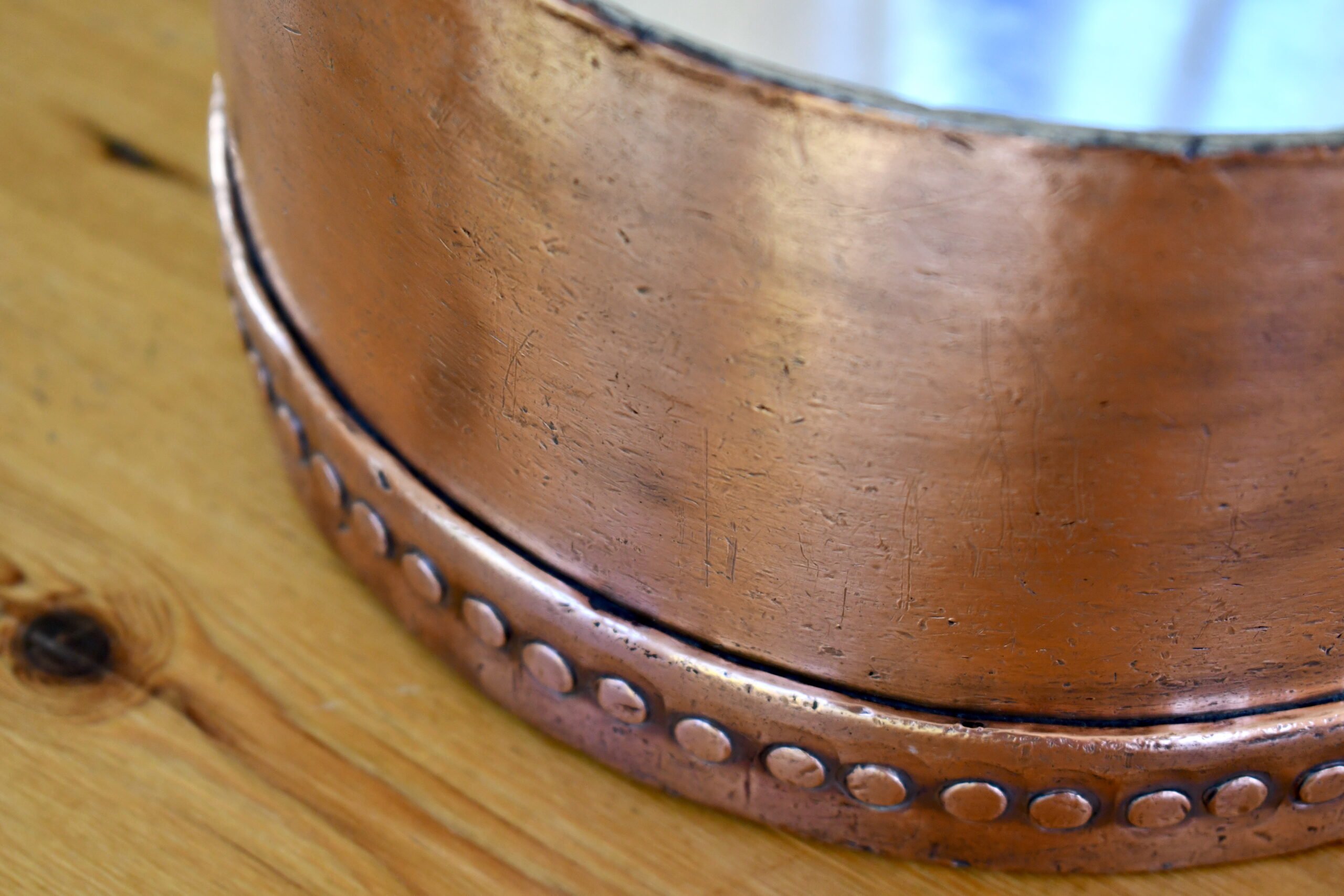
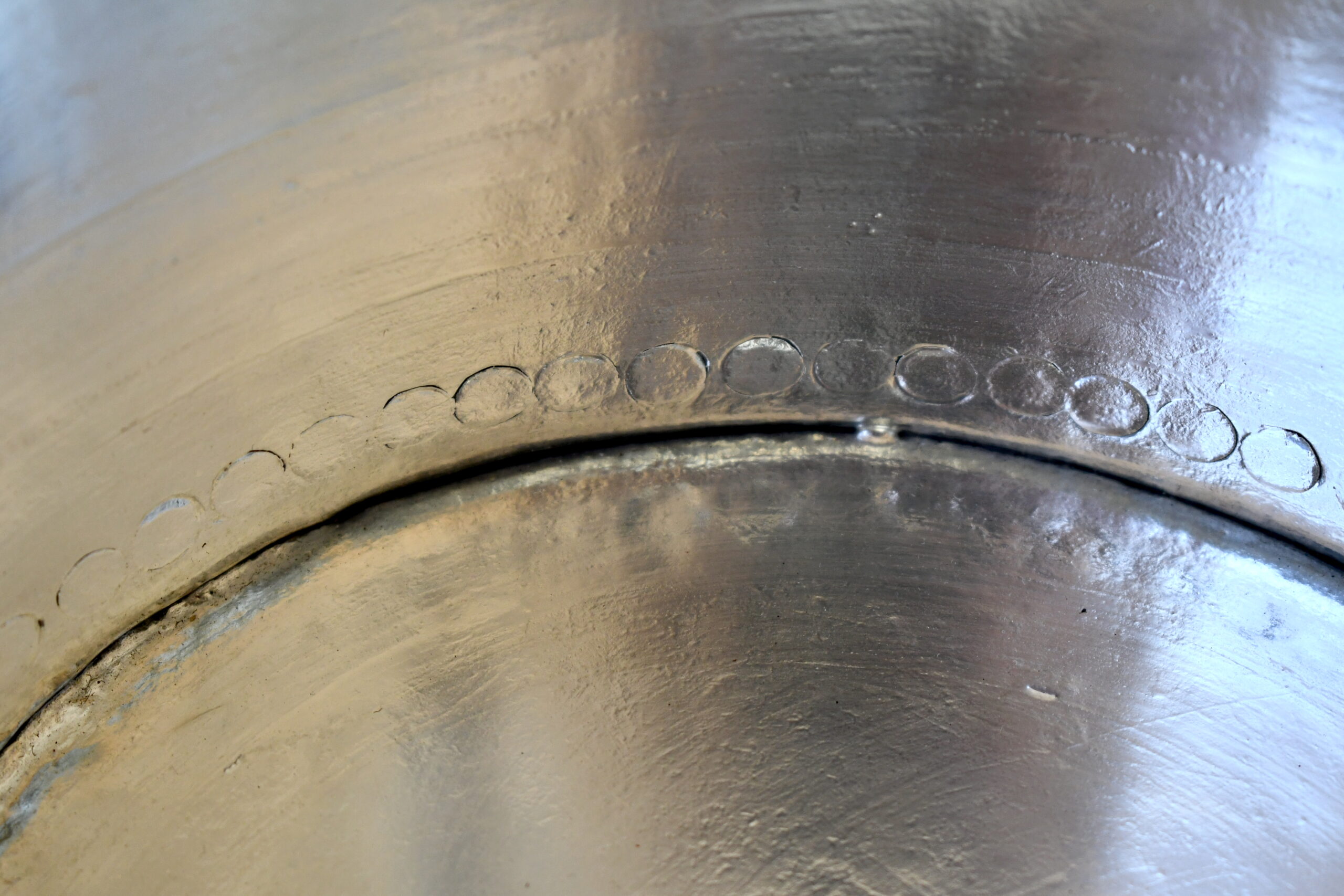
I see no signs of brazing or welding and that strikes me as unusual. I would expect to see some kind of filler in the gaps to render the seam water-tight, as is done for a dovetail seam. The join of this pot’s sidewalls to its base relies only on a tight fit and the close-set rivets — there is no sealant between the pieces. Why was this repair done in this manner? Val Maguire at Southwest Hand Tinning restored this pot and has a theory.
I think the owner of this pan had a master boilermaker in his or her life that took it upon himself to make the repair using the expertise and skills at his disposal. Brazing is an art in and of itself and if this were in the kitchen of a rural village inn, it’s possible that the cost or availability of a braze repair would have been prohibitive.
I like Val’s theory — this pot does have a sort of steampunk look to it. And I think the work is exquisite.
The rivets around the base add quite a lot of mass to the pot. It weighs 5158g (11.4 lbs), and to put that in perspective, let’s compare it to some comparable recent-era Mauviel of consistent thickness as well as some antique bottom-heavy Dehillerin.
| Diameter | Height | Rim (mm) |
Weight | |
| 1960s-90s Mauviel (consistent thickness) |
22.0 (8.7 inches) |
12.0 (4.7 inches) |
3.1 | 3326g (7.3 lbs) |
| 1890s-1900 Dehillerin (bottom heavy) |
22.0 (8.7 inches) |
12.5 (4.9 inches) |
2.5 | 3394g (7.5 lbs) |
| This pan | 23.0 (9.1 inches) |
12.0 (4.7 inches) |
2.8 | 5158g (11.4 lbs) |
| 1960s-90s Mauviel (consistent thickness) |
24.0 (9.4 inches) |
14.5 (5.7 inches) |
2.7 | 4300g (9.5 lbs) |
| 1890s-1900 Dehillerin (bottom-heavy) |
24.0 (9.4 inches) |
13.0 (5.1 inches) |
2.8 | 4554g (10 lbs) |
This pot is by far the heaviest of the bunch. It’s not just bottom-heavy but bottom-massive. If the sidewalls are 2.8 to 3mm thick and the base piece is 2.5mm thick, the pan should weigh somewhere around 3800g. Instead, it’s more than a kilo heavier and that extra weight has to be coming from the overlap and the rivets.
All that extra mass is arrayed around the perimeter of the base where it’s not in direct contact with food. How will this pan behave on the stovetop? If this pot were made of anything but copper, the metal would pull heat away from the food inside the pot. However, copper is so thermally conductive that I don’t think this would happen. I think the extra copper around the base would act as a sort of heat storage, absorbing and retaining heat that the copper base and sidewalls would distribute. What that suggests to me is that this 2.5-2.8mm pot would perform like thicker copper — that is, retaining heat and slowing down temperature shifts — because the base and sidewalls are depositing to and withdrawing heat from the “heat bank” around the edge of the rim. What do you think of this idea?
The handle
The base is not the only part of this pot that has been replaced. If you look closely at the rivets holding the handle in place you will see additional patched holes peeking out on the underside of the handle, and corresponding patches on the interior as well, just below the existing rivets.
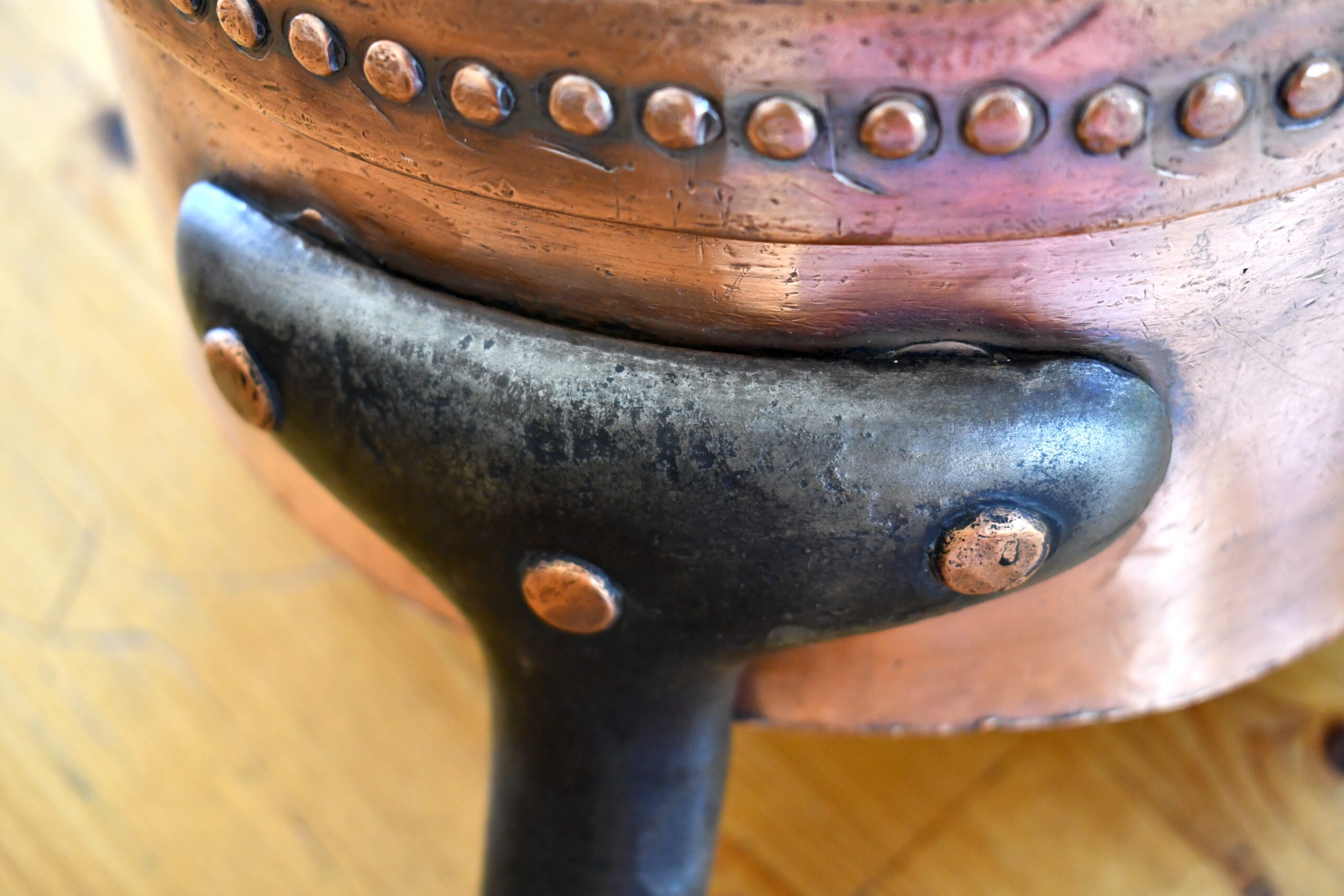

Clearly this is not the original handle. Handle repair and rivet replacement is a routine process for well-used pots but the original holes shouldn’t need to be changed. Here, the smith patched the existing holes and cut three new ones, which would only be necessary for a new handle with a different geometry of drilled holes. My theory is that the handle was changed as a consequence of the added weight of the new riveted base. The original holes are more closely set, suggesting that the original handle had a smaller baseplate; the current handle has a broader baseplate designed for a larger and heavier pot, and that’s a good thing.
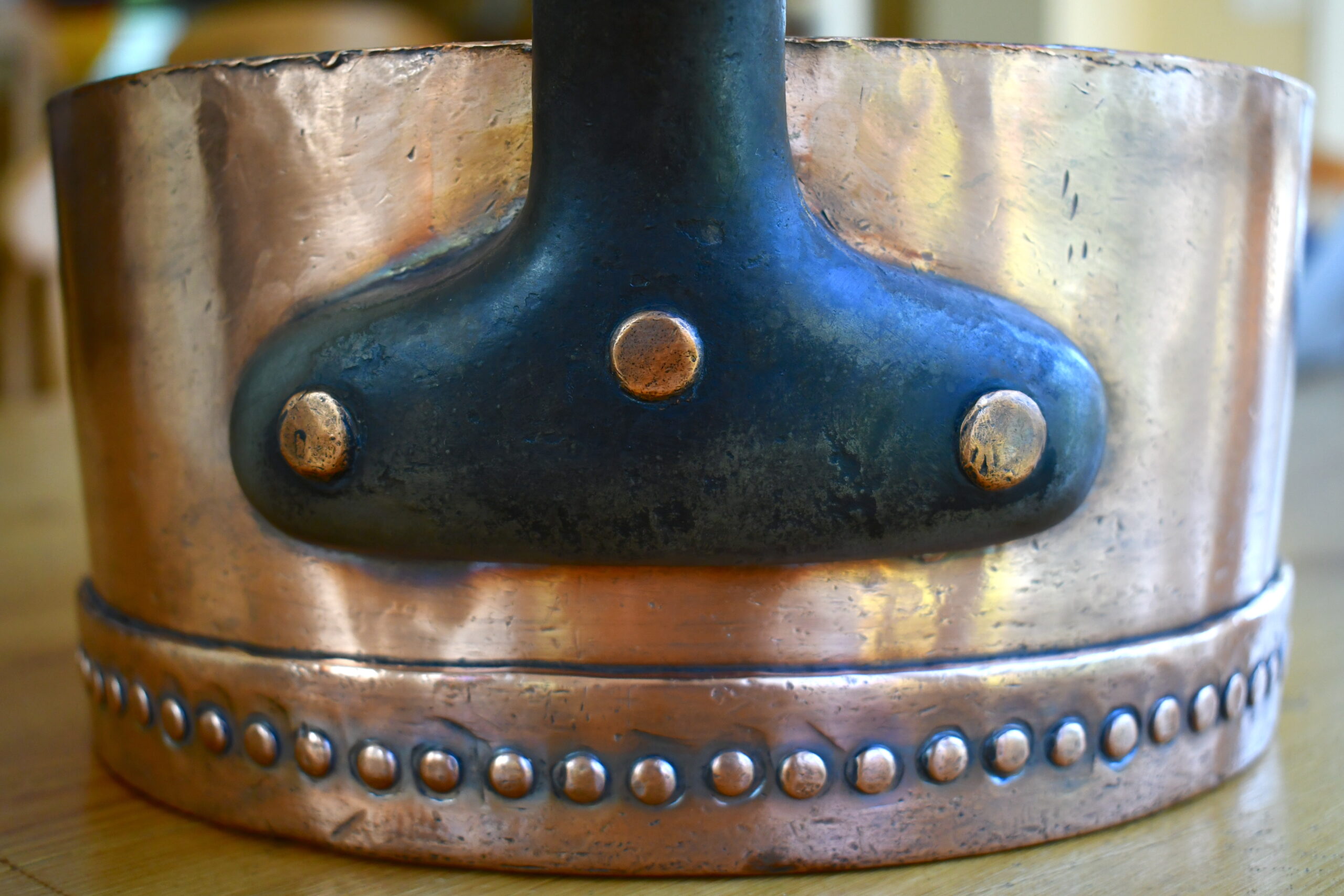
So this is the tale that I hear this pot tell: It was a lovely well-made saucepan until mischance nearly destroyed it. Then came a second chance — it was brought back to life. It received a new base, heavy and unwieldy, and a different handle broad enough to bear its weight. What had been a conventional object became something unusual.
It was remade into a new creation.


Please forgive me — the temptation to make a popular culture allusion proved too strong to resist. The original Frankenpan is this 30cm sauté pan, also repaired with a new base and handle but not nearly as skillfully as this one. This will be its mate, the Bride of Frankenpan.

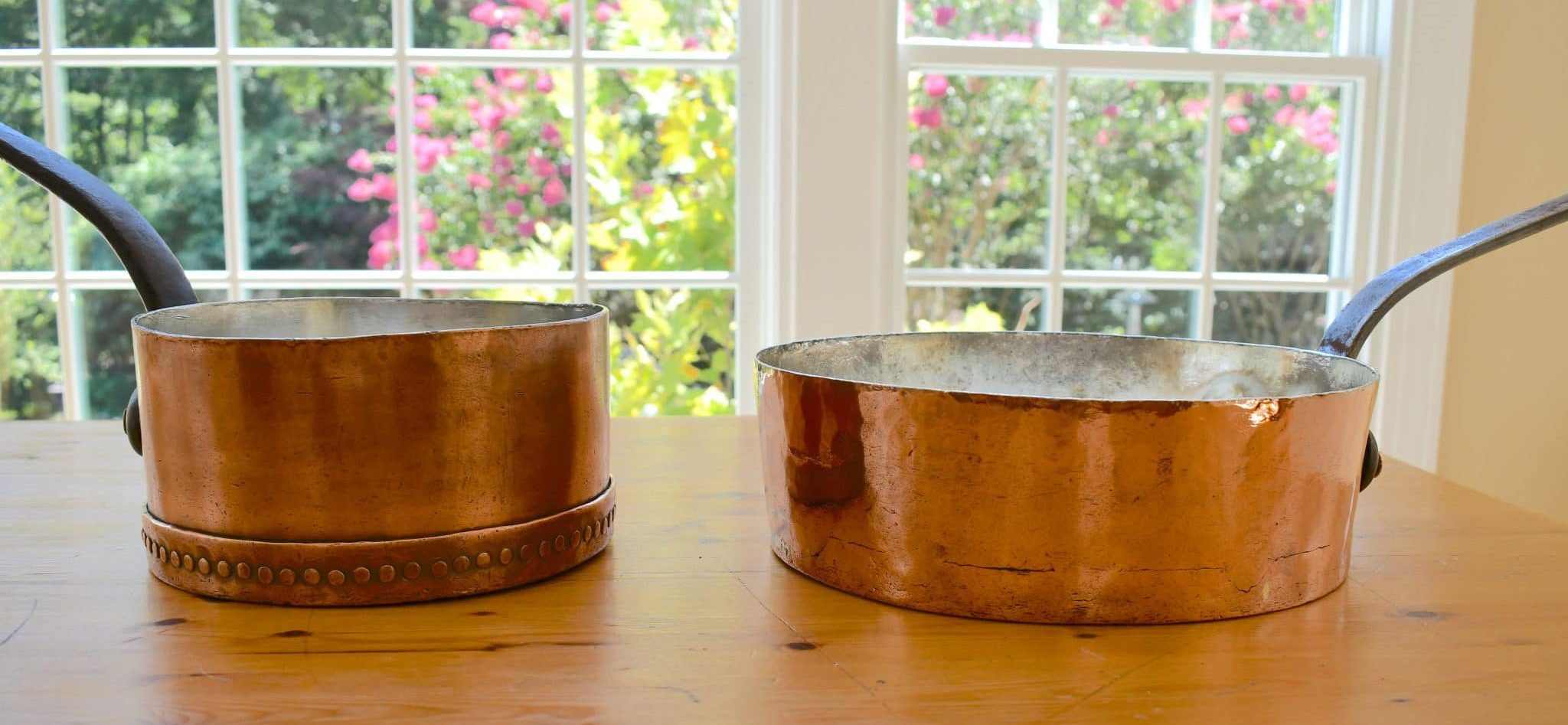
I’d like to thank Val Maguire at Southwest Hand Tinning for her restoration of this pot. As you can see, she retinned it without disrupting the patina that had accumulated on the exterior, and that takes skill and sensitivity. I’m so glad to have this pot in my collection and I am grateful to Val for preparing it for its next century.






What a beautiful and fitting name for this extraordinary pan! I had seen her on Etsy, but, as so often, VFC was more decisive than I was. As I now see, this was a good thing, since Frankenstein now got a pretty bride. Please excuse me if I now discovered a special department at VFC that offers itself as a matchmaker for copper pots.
If I remember correctly, I had doubts whether this extraordinary repair actually led to a waterproof result. But now I have been instructed otherwise. I am quite convinced that the reinforcement close to the base brings similar advantages for cooking as a thick bottom.
I am always happy when VFC was able to add a new showpiece to their treasure chest and make it accessible to us. As always arranged in the historical context and supplemented with thoughtful explanations of the construction of a pan.
Martin, to be honest, I don’t know if it’s watertight! I will have to try it out! Val reported that when she retinned it, quite a bit of grease came out of the seam…!
I forgot something. In the last photo, the top end of the pot looks uneven, as if the height were different. Is this so?
Hey Martin! Yes, the rim is uneven — it varies by about a centimeter around the circumference. I actually photographed it and planned to discuss it in the post but I didn’t know what to conclude. If the pot had been cut down, wouldn’t the original handle holes appear *higher* on the pan wall than they do? Or has the pot always this uneven? I always struggle with my tendency to long-windedness in these posts, and in this case I cut this commentary out because I didn’t know what to conclude about it. What do you think? How and why would a pan be cut down?
Hi,
There is a website called “past imperfect the art of inventive repair” , a collection of repairs. Objects sacred, sentimental or irreplaceable that former owners went to often extraordinary lengths to preserve. Often the repair exhibits more skill than the original fabrication. It is well worth a visit.
This pan plainly falls into category of repaired beyond reason so why? A metal worker who could do this could surely raise the copper further and make a new pan with less effort than this took. I find it unlikely that any cook of chef became so attached to a pan, if so why not spend on a repair that preserved the characteristics that were so prized.
I think this is a “desert island repair” one done of necessity with materials available. I suggest Great War period, no new pans to be had, no copper available so maybe a little used skillet lid from a large pan in the kitchen was sacrificed, not large enough to to make a whole body but a functional repair, yes. One can just imagine an elderly craftsman delaying retirement to do this work.
Roger, I agree, there is more going on with this repair than a straightforward cost-benefit decision. I wish I knew the whole story. It does feel to me that the work was done with exceptional care. In my experience a copper piece picks up the touch of its users over time — the really old stuff that has passed through many hands feels soft and worn-in to me, like a well-loved leather baseball mitt. This pot has got that feeling — the repair is fully integrated into the pot, if that makes sense. This is one of those acquisitions that proved more pleasing in person (so to speak) than I had expected, and I’m really glad I have it.
LOL, maybe it was the tightly packed grease that made it watertight! i have to wonder if this was made by a coppersmith with time on his hands that came across a wrecked saucepan and decided to exercise his skill and make it functional again.
Steve, I think that’s absolutely correct! I’ll have to, uh, re-seal it myself!
Just cook some eggs in it. Very old trick to seal a leaky car radiator was to put a beaten egg into the water when cold and go for a drive.(I don’t recommend this in your modern car!)
VFC, classic car enthusiasts often particularly like those cars they have had to work on for the longest time. Good luck!
We can only speculate about this pan, as is so often the case with our topic. Its original design, the reason for the revision or the need for repair will probably remain a mystery. That does not bother me. The joy of finding answers or solutions anyway has a short half-life. Problems are more interesting. The pan is as it is. In terms of craftsmanship, it may have some imperfections and shortcomings, but you can also see a high level of commitment. If you look at it more emotionally or aesthetically, you like it or you don’t like it. This cannot be discussed meaningfully. In my eyes the pan is definitely exceptional.
Roger recently introduced us to a cut pot. I could understand his guess as to why this happened. After all, over the decades, the manufacturers have always designed new proportions (average to high) according to the cooking requirements. So someone “designed” these “invalids” according to their individual wishes.
Lower handles with rather tall pots are not unusual and can offer ergonomic advantages. The handles of Bourgeat are slightly lower in modern pans compared to Mauviel pans. I could see much more extreme differences in design in large English pots, the handles of which were set extremely low when compared to French stockpots. I suspect that such pots are much easier to move around on a stove, especially when they are filled.
Studying this further I am thinking that the handle replacement is much later. The base is 19th century craftsmanship, or at least done by someone trained in that era. I can’t ever remember seeing dome headed rivets like those securing the handle on any pan made before about 1950.
There is something about the way the handle rises from the body of the pan before lowering and the angle at which it turns that says saute pan to me. Someone may indeed have been raiding the graveyard.